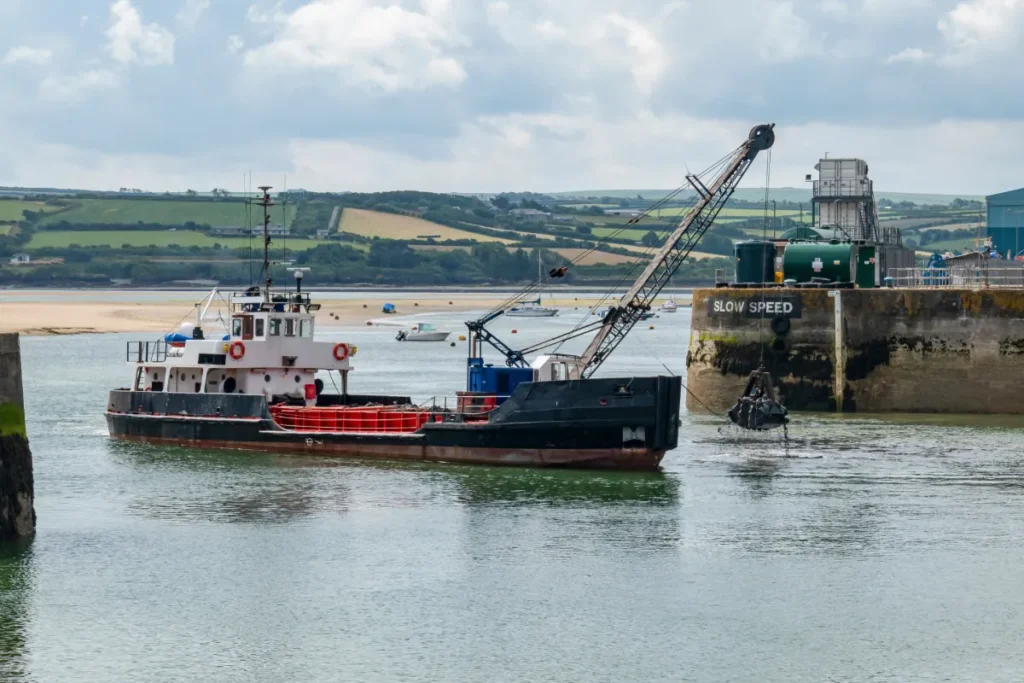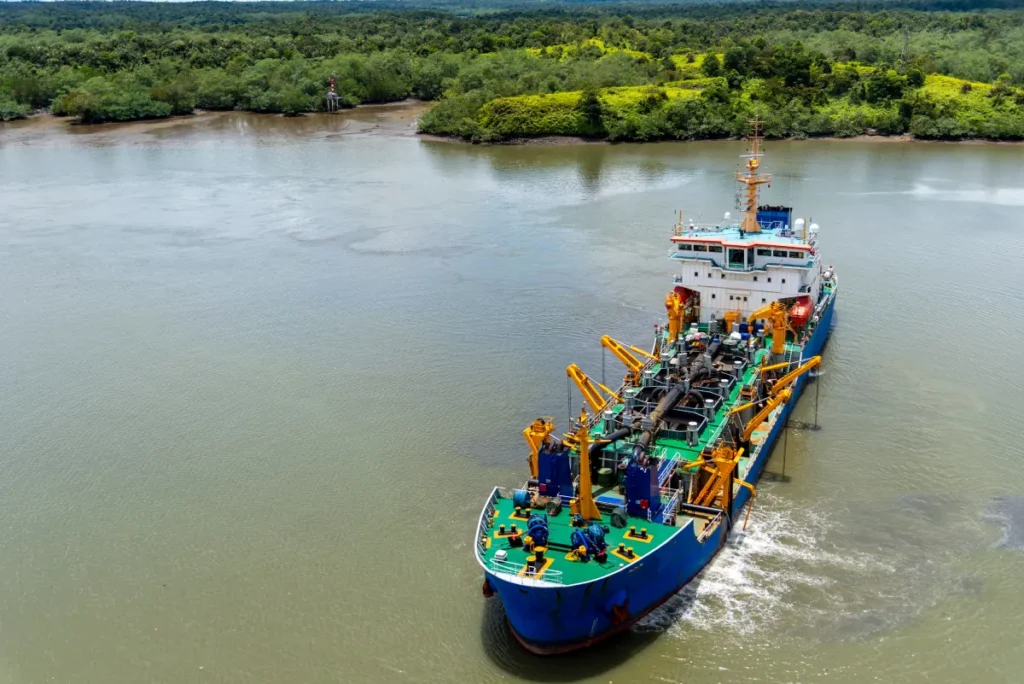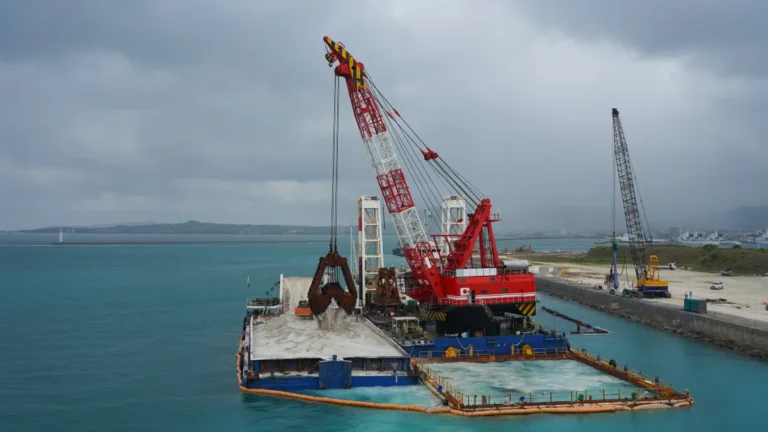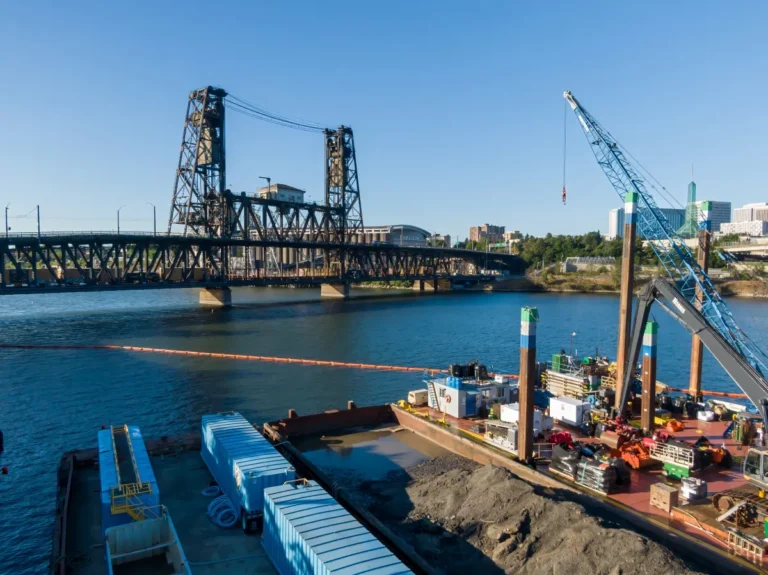Managing sediment through dredging and dewatering is essential for keeping waterways navigable, infrastructure stable, and ecosystems healthy. However, these projects come with unique technical, environmental, and regulatory challenges that can complicate even the most routine operations. From handling waterlogged sediment to meeting complex permitting requirements, successful outcomes depend on proactive planning, the right expertise, and efficient coordination across all phases. Understanding these challenges and how to overcome them can help project managers avoid costly delays and ensure long-term sustainability.

Challenge 1: Handling High Water Content in Dredged Material
One of the most common and costly challenges in dredging and dewatering projects is managing the high water content of freshly dredged sediment. When material is excavated from lagoons, harbors, or retention basins, it often contains up to 80 percent water. This excess moisture significantly increases the material’s weight and volume, making it cumbersome and expensive to transport and dispose of.
Beyond logistics, water-saturated sediment can cause operational delays and safety hazards. Wet, unstable material is harder to handle, more prone to spillage, and requires more equipment and labor to manage effectively. Without proper dewatering service processes in place, what begins as a routine dredging service can quickly become a logistical and financial burden.
The Solution: Efficient Dewatering Methods
To address these issues, professional dredging and dewatering operations rely on proven dewatering techniques that separate water from solids, greatly reducing the volume and weight of the dredged material. Some of the most effective methods include:
- Geotextile Tubes: These large, permeable fabric containers are filled with dredged slurry. Water drains through the fabric while solids remain inside, forming a drier, more manageable material.
- Filter Presses: Mechanical systems that apply pressure to force water out of sediment, producing a compact, dry cake suitable for disposal or reuse.
- Settling Ponds: A passive method where sediment is placed in a pond, allowing gravity to separate solids from water over time.
Each method can be customized based on the sediment type, site conditions, and project timeline. An experienced dewatering service provider will assess all variables to select the most efficient approach. When these techniques are integrated into a comprehensive dredging service, they help reduce costs, improve safety, and ensure regulatory compliance.

Challenge 2: Equipment Wear and Tear
In any dredging and dewatering project, equipment is pushed to its limits. From clamshell buckets to cutterheads and hydraulic pumps, every component is exposed to intense mechanical stress and harsh environmental conditions. Sediment often contains abrasive materials, such as sand, gravel, and shell fragments, that wear down cutting edges and moving parts. In marine settings, saltwater adds another layer of risk by accelerating corrosion.
These conditions can lead to breakdowns, costly repairs, and extended downtime. When a piece of dredging equipment fails mid-operation, it disrupts workflow and increases the total project cost. Routine maintenance becomes more frequent, and replacement parts can be difficult or expensive to source on short notice.
The Solution: Proactive Maintenance and Equipment Strategy
To reduce downtime and extend equipment life, professional dredging service providers implement advanced maintenance strategies:
- Routine Inspections: Regular checks of high-stress components, such as booms, hydraulic lines, and bucket teeth, help detect early signs of wear or fatigue.
- Wear-Resistant Materials: Upgrading to components made from hardened steel or corrosion-resistant alloys can significantly improve durability, especially in abrasive or saltwater environments.
- Protective Coatings: Applying anti-corrosion coatings to key equipment parts helps reduce rust, pitting, and structural degradation.
- Predictive Maintenance Technology: Using onboard sensors and real-time monitoring, operators can track equipment performance and schedule maintenance before failures occur.
- Skilled Operators: Well-trained crews know how to use equipment efficiently, avoiding overloading or operating at improper angles that accelerate wear.
Integrating these strategies into your dredging and dewatering plan not only improves productivity but also reduces long-term operating costs. An experienced dredging service partner will have the tools, materials, and protocols in place to maintain equipment efficiency from start to finish.

Challenge 3: Regulatory Compliance and Permitting
Navigating the regulatory landscape is one of the most complex aspects of any dredging and dewatering project. Local, state, and federal agencies impose strict guidelines to protect waterways, ecosystems, and surrounding communities. Before any sediment is moved, permits must be secured, and environmental assessments are often required. Delays in this stage can stall entire projects, adding significant time and cost.
Permit requirements vary depending on the location and type of water body, as well as the nature of the material being removed. Projects near protected habitats or involving contaminated sediment face even more scrutiny. Failure to comply with environmental regulations can result in fines, legal challenges, and reputational damage, particularly for municipalities or industrial operators under public oversight.
The Solution: Expert Navigation and Early Planning
Experienced dredging service and dewatering service providers play a critical role in streamlining compliance. They understand regulatory frameworks and work closely with environmental consultants and permitting agencies to anticipate potential challenges. Key strategies include:
- Environmental Impact Assessments (EIAs): Conducting detailed studies to evaluate how dredging activities could affect water quality, marine life, and nearby habitats.
- Early Agency Engagement: Involving regulators at the start of planning to address concerns proactively and minimize delays.
- Permit Coordination: Preparing and submitting all required documentation to ensure projects meet Clean Water Act standards and other relevant regulations.
- Adaptive Project Design: Modifying schedules, equipment, or dredging methods in response to regulatory feedback or seasonal environmental conditions.
Taking a proactive approach to compliance helps keep projects on schedule while reinforcing environmental responsibility. Once the permits are approved and operations begin, attention must turn to the next major hurdle: managing contaminated or hazardous sediment effectively.

Challenge 4: Contaminated Sediment Management
Many dredging and dewatering projects involve more than just removing clean sand or silt. In industrial zones, aging harbors, or stormwater lagoons, dredged material often contains contaminants such as heavy metals, hydrocarbons, or chemical residues. These pollutants can pose serious risks to aquatic ecosystems and public health if not handled correctly.
Disturbing contaminated sediment during dredging can release toxins into the water column, potentially impacting marine life and nearby communities. Disposal of this material is also more complex, as it cannot be transported or reused without meeting strict environmental standards. The added testing, handling, and transportation requirements can quickly drive up project costs and extend timelines.
The Solution: Careful Testing and Secure Disposal Methods
Managing contaminated material safely begins with thorough site analysis. A qualified dredging service or dewatering service provider will conduct pre-dredge sediment testing to identify pollutants and determine the most appropriate removal and disposal strategy. Effective approaches include:
- Laboratory Testing: Identifying the presence and concentration of contaminants to classify sediment as hazardous or non-hazardous.
- Containment and Transport: Using sealed containers, lined trucks, and spill-prevention protocols to move material safely.
- Confined Disposal Facilities (CDFs): Disposing of contaminated sediment in secure, engineered environments designed to isolate toxins from the surrounding ecosystem.
- Stabilization Treatments: Applying chemical or physical treatments to neutralize hazardous materials before disposal.
Some sites may allow for partial reuse of cleaned sediment, but only after rigorous testing and approval. Choosing a service provider with experience in sediment classification and regulatory compliance ensures that contaminated material is managed safely and in compliance with environmental laws.

Challenge 5: Site Constraints and Accessibility
Every dredging and dewatering project brings its own set of physical challenges, but site constraints are among the most difficult to navigate. Tight spaces, shallow waters, low-clearance bridges, and proximity to residential or environmentally sensitive areas can significantly complicate equipment mobilization and dredging operations.
In confined sites such as small marinas, stormwater ponds, or urban waterways, traditional dredging equipment may be too large or unwieldy to operate efficiently. Noise restrictions, limited staging areas, and concerns about disrupting local ecosystems further complicate the planning process. Without the right equipment or approach, these challenges can lead to delays, safety hazards, or environmental impact.
The Solution: Customized Equipment and Strategic Planning
To overcome access limitations, experienced dredging service and dewatering service providers tailor their approach to the site’s unique conditions. Rather than using a one-size-fits-all approach, they deploy purpose-built solutions that deliver precision and minimal disruption. These may include:
- Small-Scale or Modular Equipment: Compact dredgers, amphibious excavators, or barge-mounted systems that can operate in narrow or shallow areas.
- Remote and Hydraulic Dredging Options: Techniques that reduce the need for heavy machinery on site, limiting the project footprint.
- Noise and Turbidity Control Measures: Using sound-dampening equipment, silt curtains, and other best practices to meet environmental regulations and community expectations.
- Careful Scheduling: Timing operations to avoid peak traffic, tourism seasons, or critical wildlife breeding periods.
Flexibility in equipment selection and project design enables dredging teams to work efficiently even in the most restricted environments. Once the physical constraints are addressed, attention must also be given to how the project is perceived by the surrounding community and stakeholders who may be directly affected.

Challenge 6: Public Perception and Stakeholder Concerns
Even when a dredging and dewatering project is technically sound and environmentally responsible, public perception can still become a barrier. Communities located near dredging sites often raise concerns about noise, odor, traffic, water quality, or potential environmental harm. Local businesses, homeowners, recreational users, and environmental groups all have a stake in how a project unfolds.
A lack of clear communication or transparency can lead to misinformation, opposition, and delays. In areas with a history of environmental sensitivity or previous project disruptions, building trust becomes even more critical. Stakeholders want to know that their concerns are being heard and that the project will deliver long-term benefits without creating short-term disruption.
The Solution: Transparent Engagement and Community Collaboration
Leading dredging service and dewatering service providers incorporate community engagement into their project planning from the start. This helps foster trust, avoid conflict, and keep projects on track. Effective strategies include:
- Public Meetings and Briefings: Hosting informational sessions to explain the scope of work, environmental safeguards, and timelines.
- Clear Communication Channels: Providing updates through websites, signage, newsletters, or local media outlets to keep the public informed.
- Stakeholder Input Opportunities: Creating ways for residents, businesses, and environmental advocates to voice concerns and receive responses.
- Demonstrating Environmental Responsibility: Using best practices such as silt curtains, low-noise equipment, and real-time monitoring to show commitment to minimizing impact.
Engaging with the public in a meaningful way not only smooths project execution but also builds goodwill that can benefit future efforts. As public concerns are addressed and operations begin, another long-term consideration comes into focus: ensuring the sustainability and resilience of the dredged site once the work is complete.

Challenge 7: Long-Term Sustainability and Monitoring
Completing a dredging and dewatering project is only part of the equation. Without proper post-project monitoring and long-term planning, the same issues that prompted dredging in the first place can return. Sediment may reaccumulate, water quality can decline, and restored areas might begin to erode or degrade if no maintenance plan is in place.
Many projects, especially those in active waterways or near development zones, are vulnerable to re-sedimentation from runoff, tides, or upstream activity. In some cases, neglecting long-term maintenance can undo the environmental and financial investments made during dredging. This challenge becomes more significant when stakeholders expect lasting improvement, and regulatory agencies require follow-up data to confirm ecological recovery.
The Solution: Integrated Monitoring and Maintenance Strategies
To ensure lasting results, experienced dredging service and dewatering service providers recommend implementing a post-project sustainability plan. This includes:
- Water Quality Monitoring: Regular testing of turbidity, dissolved oxygen, and nutrient levels to track ecosystem health.
- Sediment Surveys: Using sonar mapping or core sampling to detect sediment buildup before it becomes a problem.
- Habitat Restoration Assessments: Evaluating vegetation reestablishment, shoreline stability, and wildlife return in areas impacted by dredging.
- Preventive Infrastructure: Installing sediment traps, vegetated buffers, or erosion control features to reduce the rate of future accumulation.
- Scheduled Maintenance Dredging: Planning smaller-scale cleanouts at regular intervals to maintain waterway depth and reduce the need for disruptive large-scale dredging.
Long-term sustainability planning adds value to the initial investment and supports both environmental resilience and infrastructure performance. It also demonstrates a commitment to stewardship that can strengthen relationships with stakeholders and regulators alike.
With environmental and operational concerns addressed, the next step is to ensure that the entire process remains aligned with all legal requirements and that stakeholders remain informed and involved throughout the project lifecycle.
Conclusion: The Key to Sustainable Dredging Outcomes
Every dredging and dewatering project presents a range of challenges, but with the right strategies and service partners in place, each one can be effectively addressed. From reducing equipment wear and managing contaminated sediment to earning community support and planning for long-term success, careful execution is key. At CA Dredge Pros, we specialize in delivering reliable dredging and dewatering service solutions that align with environmental goals and regulatory standards. If you’re planning a project and want trusted support from experienced professionals, we invite you to connect with us to learn how we can help.






